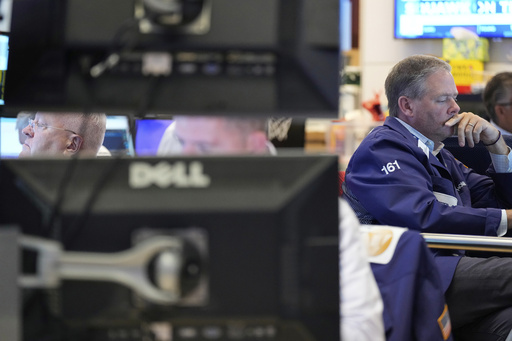Thursday saw another volatile session on Wall Street as the stock market wrapped up with losses, primarily driven by a decline in the health care sector. Initially buoyed by gains in big tech stocks, the market’s momentum dwindled, leading to the S&P 500 dropping by 0.4%. This marked the third consecutive fall for the index, which had earlier set a new record high. Despite the decline, July concluded with a 2.2% increase—accumulating a 7.8% rise for the year. The Dow Jones Industrial Average retreated by 0.7%, while the Nasdaq composite slightly dipped, finishing just under 0.1% lower.
In the S&P 500, approximately 70% of the stocks experienced losses, with health care companies exerting a considerable drag. This sector was adversely affected after the White House issued letters urging substantial pharmaceutical firms to reduce prices and implement reforms within 60 days. Consequently, Eli Lilly & Co. decreased by 2.6%, UnitedHealth Group plummeted 6.2%, and Bristol-Myers Squibb fell 5.8%. Despite the broader market’s downward trajectory, significant technological gains helped mitigate the damage.
Meta Platforms, the parent of Facebook and Instagram, surged 11.3% following a remarkable sales and profit performance, continuing to heavily invest in artificial intelligence. Similarly, Microsoft rose by 3.9% after surpassing analysts’ expectations and delivering promising updates on its Azure cloud computing services, integral to its AI strategy. The impressive performance of major tech firms continues to influence market dynamics, fueled by optimism around the future role of artificial intelligence. Meanwhile, Figma, a design software company, enjoyed a dazzling stock market initiation, soaring 250% over its IPO price of $33 per share.
Summing up the day, the S&P 500 saw a decline of 23.51 points, closing at 6,339.39. The Dow shed 330.30 points to end at 44,130.98, and the Nasdaq retreated by 7.23 points to close at 21,122.45. Investors remained focused on corporate earnings, outside the tech sphere, during a particularly busy week for financial disclosures. CVS Health, topping Wall Street’s second-quarter expectations, edged down 0.3% but lifted its full-year forecast once again.
In economic updates, the Commerce Department reported a 2.6% increase in prices for June compared to the previous year, based on the personal consumption expenditures index, the preferred inflation gauge of the Federal Reserve. This reading slightly surpassed economists’ forecasts and indicated an uptick from May’s 2.4% annual rate. Similarly, an earlier inflation measure, the consumer price index, revealed a rise in June. Simultaneously, unemployment benefits filings demonstrated a slight increase over the last week.
Recent economic data on inflation and employment surfaces amidst ongoing concerns regarding tariffs’ impact. Businesses, alongside the Fed, closely monitor inflation trends influenced by President Donald Trump’s sporadic tariff policies. Notably, firms like Ford and Hershey’s have highlighted tariffs’ detrimental effects on current and projected financial outcomes. Trump has signaled potential imposition of tariffs on goods from various countries unless trade agreements are secured by Friday. Current developments potentially involve a tariff escalation pause with China and a settled deal with South Korea.
However, Trump announced a 90-day negotiation period with Mexico, maintaining the 25% tariff rates. The motives behind trade strategies remain erratic, such as Trump’s decision on Wednesday to implement the threatened 50% tariffs against Brazil, citing a connection to the legal proceedings of Brazil’s former president Jair Bolsonaro. He also indicated that trade talks with Canada might encounter challenges following Canada’s acknowledgment of a Palestinian state, although this move bears no direct economic ties.
Persistent uncertainties about tariffs and inflation have led the Federal Reserve to maintain its benchmark interest rate through the past five policy meetings, including the one concluded on Wednesday. Although nearing its 2% inflation target, the Fed grapples with inflation slightly above this benchmark. Reducing rates could stimulate the job market and broader economy but risks increasing inflation. Despite pressure from Trump, Fed Chair Jerome Powell lacks sole authority to change rates, which is collectively decided by the twelve-member Federal Open Market Committee.
“Inflation slightly exceeds the Fed’s target, but is poised to climb in the latter half of the year due to tariffs,” remarked Bill Adams, Comerica Bank’s chief economist. “Given the robust job market, they perceive the possibility to maintain steady interest rates while addressing inflation’s near-term rise.” While Wall Street revises expectations for rate cuts in September’s Fed meeting, CME Group data reveals traders currently perceive a 39% probability, a decrease from 58.4% a week ago and 75.4% a month prior.
In the bond market, Treasury yields remained constant, with the 10-year Treasury yield stable at 4.37% and the two-year Treasury yield unaltered at 3.94%, as of Wednesday’s close. Meanwhile, global markets presented mixed performances both in Asia and Europe.


